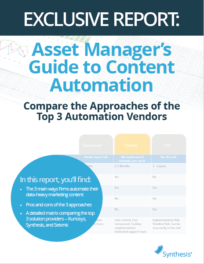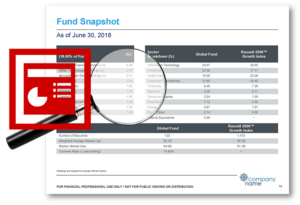Search Results for: feed
Beyond Alignment – Marketing & Sales Collaborating Through Content Automation

Guest post by Marianne Hewitt from The Growth Strategy Group.
The conversation about investment marketing and sales alignment began over a decade ago. After ten years, less than 50% of organizations surveyed said they aligned appropriately to achieve the financial results for which they are accountable.
The resistance persists because achieving the synergies between marketing and sales is not viewed as transformational. It does not get the top-down executive support it requires. Nor does it get the governance structure that major transformation initiatives require to succeed.
There was a point in time when alignment between the two organizations made perfect sense. In today’s digital world where buyers prefer digital self-service (Figure 1) and remote human engagement, it is no longer the right way to think about the relationship between marketing and sales.
Four Ways Asset Management Marketers Can Grow AUM

The shift from active to passive investing continues to drive significant change for investment management sales and marketing. In this article, investment marketing consultants Sandra Powers Murphy and Donna DiMaria explain what marketers can do to help their firms grow AUM in today’s challenging environment.
According to DiMaria, operational efficiency in sales and marketing has become imperative, and asset managers are taking note.
“Firms are looking to be more efficient, doing more with fewer resources both in terms of bodies and budget. And that is leading to consolidation, outsourcing, and automation. The status quo isn’t working anymore so, in a way, the market is recreating itself,” she said.
Content Automation: A Competitive Necessity

Content automation has become a necessity, rather than a luxury, for most asset managers in today’s highly competitive environment. According to a survey of asset managers by the Fuse Research Network and Synthesis Technology, 95% of respondents use some kind of tool or process for automating content production. Most commonly, they use it for the creation of factsheets and pitchbooks.
The need for content automation is justifiable. Marketers need to get sales and marketing materials in the hands of salespeople, clients, and prospects as fast as possible. Now, investors, advisors, and consultants expect more frequent and timely product updates.
When implemented successfully, content automation solutions empower firms to produce fully compliant, client-ready sales and marketing content faster than their competitors. These tools reduce labor costs and relieve talented marketing professionals from the drudgery of content production. They minimize the potential for human errors that inadvertently deliver inaccurate and non-compliant information to the public. Plus, they eliminate one of the most common compliance headaches many asset managers face: keeping salespeople from stitching together their own non-compliant pitchbooks from a patchwork of outdated sales presentations.
Effective content automation solutions require two components: An in-house or commercial production tool and a reliable source of product data to populate the finished pieces. Unfortunately, data management is content automation’s Achilles heel for many firms.
Are Data Bottlenecks Impacting Your Bottom Line?

Asset management sales and marketing efforts are fueled by data. The faster firms get clean, accurate product performance data in the hands of consultants, advisors and wholesalers, the better their chances of closing deals and increasing inflows. Effective governance for investment data is the foundation for this effort.
A growing number of firms are using marketing content automation solutions to quickly create and update pitchbooks, collateral materials and website product pages. Yet, many are still using inefficient, ad hoc processes for collecting, storing and distributing the source data that populates these communications.
These processes, coupled with a lack of formal governance around data collection and usage, increase product information’s time-to-market. Also, they raise the likelihood of errors that could result in reputational damage and regulatory sanctions.




 Compare the Top 3 Finserv Content Automation Vendors [White paper]
Compare the Top 3 Finserv Content Automation Vendors [White paper] Create Pitchbooks the Drive Sales [White paper]
Create Pitchbooks the Drive Sales [White paper] Build vs. Buy: Should Your Financial Services Firm Outsource or Insource Marketing Technology? [White paper]
Build vs. Buy: Should Your Financial Services Firm Outsource or Insource Marketing Technology? [White paper]  10 Tips for Rebranding your Fund Marketing Documents [White paper]
10 Tips for Rebranding your Fund Marketing Documents [White paper]




